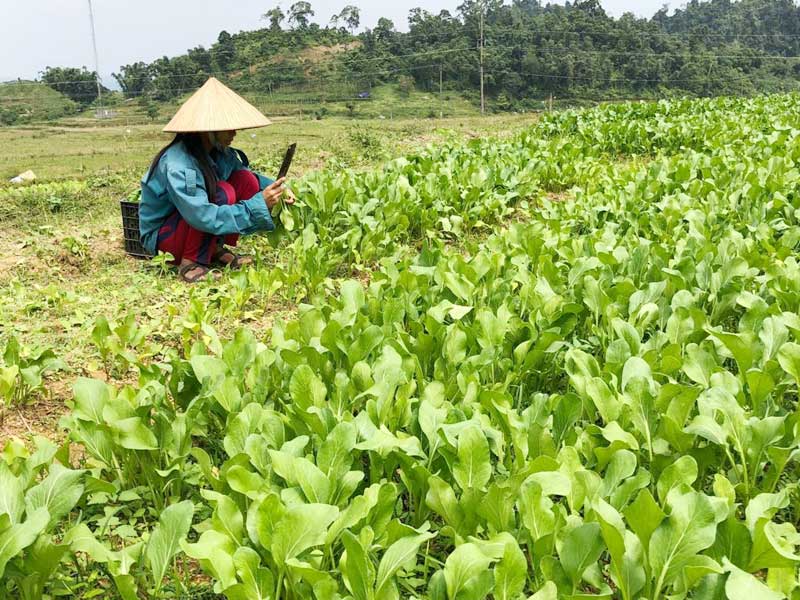
(HBO) - Tan Son commune, located in an extremely difficult area of Mai Chau district, is flourishing in agricultural production, which helps improve income and better living standards of local residents, and contributes to the new-style rural development in the locality.
Farmers in Tam Hoa village, Tan Son commune (Mai Chau district) are
growing vegetables in the production-consumption model, which has helped improve
their incomes.
The cultivable land of Bo Bau and Tam Hoa villages
of Tan Son commune is covered by the green colour of lime trees and vegetables.
Ha Van Dung, Chairman of the communal People’s Committee, said how to change the
structure of plants has long been the concern of the local authorities and
Party Committee.
From 2017, the landmark transformation has helped to bring hope for locals and improve
their livelihood. Production models coupled with consumption of key
agricultural products have been formed. Notably, a lime growing model - the
cooperation between local farmers and the Nafood Tay Bac Company - was formed.
A total of 40 households participating in
the model have been provided with training on science and farming techniques.
They have got helps to access loans through the district’s agricultural
development project for purchasing materials and fertiliser.
The model has been expanded in scale with
an area of 4.3 hectares. Households that join the model through shifting the cultivation
of cassava, maize and other ineffective plants to the growing of lime have
earned tens of millions of VND per crop.
Instead of selling products at low and unstable
prices, now products made by locals are purchased by enterprises with the
stable price at 15,000 VND/kg.
Another safe vegetable cultivation model in the production-consumption chain is
also actively implemented in the locality, and the area of this model is hoped
to increase by 10 ha in the end of 2018. Initiated in July 2018, the model
provided the two first products of cabbage and choy sum. All the cultivation areas
of vegetables meet VietGap
standards in terms of quality, output and value. With
the model, enterprises also buy products at the garden with the price committed
in the contract.
The family of Mrs. Ha Thi Y, one of households joining the model
in the Na Co Nao production area in Tam Hoa village said it is not
difficult to grow vegetables because her family has been provided vegetable farming
techniques.
The cultivation is also suitable with the investment ability of farmers, she stressed, adding that the cultivation
of this kind has helped local farmers increase their incomes by 2-3 times
compared to the growing of rice.
According to data from the Hoa Binh Provincial Party Committee, the industrial production index for the first six months of 2025 is estimated to have increased by 20% compared to the same period last year. This marks the highest year-on-year growth rate for this period since 2020.
In the first six months of 2025, Hoa Binh province’s export turnover was estimated at 1.145 billion USD, marking an 18.11% increase compared to the same period in 2024. Import turnover was estimated at $ 804 million, a 17.15% increase, which helped the province maintain a positive trade balance.
The lives of the ethnic minority farmers in Tan Lac district have gradually improved thanks to the new directions in agricultural production. This is a testament to the collective strength fostered through the professional associations and groups implemented by various levels of the district’s Farmers’ Union.
With the motto the "product quality comes first,” after nearly one year of establishment and operation, Muong village’s Clean Food Agricultural and Commercial Cooperative, located in Cau Hamlet, Hung Son Commune (Kim Boi district), has launched reputable, high-quality agricultural products to the market that are well-received by consumers. The products such as Muong village’s pork sausage, salt-cured chicken, and salt-cured pork hocks have gradually carved out a place in the market and they are on the path to obtaining the OCOP certification.
In the past, the phrase "bumper harvest, rock-bottom prices" was a familiar refrain for Vietnamese farmers engaged in fragmented, small-scale agriculture. But today, a new spirit is emerging across rural areas of Hoa Binh province - one of collaboration, organisation, and collective economic models that provide a stable foundation for production.
Maintaining growing area codes and packing facility codes in accordance with regulations is a mandatory requirement for agricultural products to be eligible for export. Recently, the Department of Agriculture and Environment of Hoa Binh province has intensified technical supervision of designated farming areas and packing facilities to safeguard the "green passport" that enables its products to access international markets.



